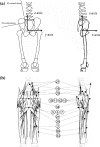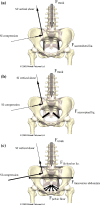Biomechanical analysis of reducing sacroiliac joint shear load by optimization of pelvic muscle and ligament forces
- PMID: 18204902
- PMCID: PMC2239251
- DOI: 10.1007/s10439-007-9385-8
Biomechanical analysis of reducing sacroiliac joint shear load by optimization of pelvic muscle and ligament forces
Abstract
Effective stabilization of the sacroiliac joints (SIJ) is essential, since spinal loading is transferred via the SIJ to the coxal bones, and further to the legs. We performed a biomechanical analysis of SIJ stability in terms of reduced SIJ shear force in standing posture using a validated static 3-D simulation model. This model contained 100 muscle elements, 8 ligaments, and 8 joints in trunk, pelvis, and upper legs. Initially, the model was set up to minimize the maximum muscle stress. In this situation, the trunk load was mainly balanced between the coxal bones by vertical SIJ shear force. An imposed reduction of the vertical SIJ shear by 20% resulted in 70% increase of SIJ compression force due to activation of hip flexors and counteracting hip extensors. Another 20% reduction of the vertical SIJ shear force resulted in further increase of SIJ compression force by 400%, due to activation of the transversely oriented M. transversus abdominis and pelvic floor muscles. The M. transversus abdominis crosses the SIJ and clamps the sacrum between the coxal bones. Moreover, the pelvic floor muscles oppose lateral movement of the coxal bones, which stabilizes the position of the sacrum between the coxal bones (the pelvic arc). Our results suggest that training of the M. transversus abdominis and the pelvic floor muscles could help to relieve SI-joint related pelvic pain.
Figures




References
-
- {'text': '', 'ref_index': 1, 'ids': [{'type': 'DOI', 'value': '10.1016/0268-0033(95)90432-9', 'is_inner': False, 'url': 'https://doi.org/10.1016/0268-0033(95)90432-9'}, {'type': 'PubMed', 'value': '11415526', 'is_inner': True, 'url': 'https://pubmed.ncbi.nlm.nih.gov/11415526/'}]}
- Adams M. A., Dolan P. Recent advances in lumbar spinal mechanics and their clinical significance Clin. Biomech. 10:3–19, 1995 - PubMed
-
- {'text': '', 'ref_index': 1, 'ids': [{'type': 'DOI', 'value': '10.1016/0021-9290(85)90012-0', 'is_inner': False, 'url': 'https://doi.org/10.1016/0021-9290(85)90012-0'}, {'type': 'PubMed', 'value': '4055812', 'is_inner': True, 'url': 'https://pubmed.ncbi.nlm.nih.gov/4055812/'}]}
- Anderson C. K., Chaffin D. B., Herrin G. D., Matthews L. S. A biomechanical model of the lumbosacral joint during lifting activities. J. Biomech. 18:571–584, 1985 - PubMed
-
- {'text': '', 'ref_index': 1, 'ids': [{'type': 'DOI', 'value': '10.1016/0268-0033(96)00033-2', 'is_inner': False, 'url': 'https://doi.org/10.1016/0268-0033(96)00033-2'}, {'type': 'PubMed', 'value': '11415651', 'is_inner': True, 'url': 'https://pubmed.ncbi.nlm.nih.gov/11415651/'}]}
- Andersson E. A., Oddsson L. I. E., Grundstrom H., Nilsson J., Thorstensson A. EMG activities of the quadratus lumborum and erector spinae muscles during flexion–relaxation and other motor tasks. Clin. Biomech. 11:392–400, 1996 - PubMed
-
- {'text': '', 'ref_index': 1, 'ids': [{'type': 'PubMed', 'value': '7154650', 'is_inner': True, 'url': 'https://pubmed.ncbi.nlm.nih.gov/7154650/'}]}
- Brand R. A., Crowninshield R. D., Wittstock C. E., Pedersen D. R., Clark C. R., van Krieken F. M. A model of lower extremity muscular anatomy J. Biomech. 104:304–310, 1982 - PubMed
-
- {'text': '', 'ref_index': 1, 'ids': [{'type': 'DOI', 'value': '10.1016/0021-9290(86)90164-8', 'is_inner': False, 'url': 'https://doi.org/10.1016/0021-9290(86)90164-8'}, {'type': 'PubMed', 'value': '3771581', 'is_inner': True, 'url': 'https://pubmed.ncbi.nlm.nih.gov/3771581/'}]}
- Brand R. A., Pedersen D. R., Friederich J. A. The sensitivity of muscle force predictions to changes in physiologic cross-sectional area. J. Biomech. 19:589–596, 1986 - PubMed
MeSH terms
LinkOut - more resources
Full Text Sources
Medical

